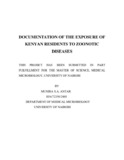| dc.description.abstract | Introduction: Zoonoses can be transmitted from animals to humans, primarily by ingestion, bites (animal or arthropod), scratches, inhalation or direct skin/mucosal contact. 'They are strongly identified with emerging disease issues and are of global concern due to their link to the environment and the sudden nature in which they appear.
In Kenya, it is anticipated that there may be an under-diagnosis and/or under reporting of zoonotic diseases. It is in this context that we needed to determine the prevalence of antibodies against selected zoonoses.
Methods: In a Cl'OSS- sectional study conducted at Coast Provincial General Hospital and Mbagathi District Hospital between January and March 201 L we determined the seroprevalcnces against selected zoonoses using Enzyme linked immunosorbent assay (ELISA) from serum samples. Patients with fevers were eligible.
In this study, 182 patients were recruited (91 from each hospital). A questionnaire was administered that included assessment of demographics, clinical presentations and history of recent travel. A complete blood count was also done for each patient. The data collected was entered into MS Excel and later analysed using SPSS.
Results: Sixty percent of all patients were positive for serum antibodies against a number of zoonotic disease. Dengue fever virus, IgM prevalence was 8.2% and IgG prevalence was 35.2%. Overall Flavivirus (both WNV and Dengue) IgG prevalence was 63.7%. West Nile fever virus, IgM prevalence was 1.6%. Rift Valley fever virus IgG prevalence was 7.1 (% and Coxiella burnetii IgG prevalence was 5.5%. Rickettsia rickettsii IgG prevalence was 2.7% and Rickettsia typhi IgG prevalence was 0.5%. Leptospira IgM prevalence was 0.5%. Significant factors were history of recent travel (p=0.010), .age (p= 0.004), presenting symptoms (p=O.004) and region of residence (p=O.OOO).
Conclusion: Dengue fever had the highest serum antibody prevalence in both Mombasa and Nairobi while Leptospira and Rickettsia typhi had the lowest serum antibody prevalence. Some of the Dengue IgM positive patients may have been ill due to dengue fever. It is possible that a certain number of dengue acute cases might have already cleared dengue virus from the sera at the time of testing despite negative PCRs.
NS 1 testing could be carried out as a supplemental when time and resources allow (33). This study showed that age, history of recent travel and abnormal haematological factors were all risk factors associated with prevalence of serum antibodies against a number of zoonotic diseases. | en_US |

